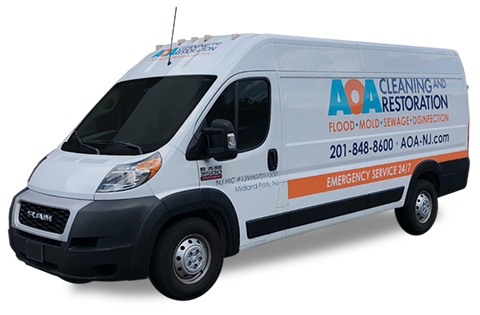Did you know that about 98% of basements in the U.S. will face water damage at some point? This shows how common and important fixing basement water damage is for homeowners. It can happen from a single leak or ongoing water pressure. Quick action is key to avoid more damage and health risks like mold.
When dealing with basement water damage, safety comes first. Stay away from floodwaters to avoid dangers like electrocution. It’s also important to find out where the water is coming from. Whether you’re fixing it yourself or getting help, knowing the cause is key to fixing it right.
First steps usually include removing water with pumps or vacuums and getting rid of wet materials to stop mold. For ongoing problems, installing a good sump pump or interior drainage can help keep water out.
Key Takeaways
- 98% of U.S. basements will experience water damage at some point, highlighting the necessity for preparedness.
- Hydrostatic pressure can cause water to seep through the concrete, leading to foundational issues.
- Immediate removal of standing water and wet materials is vital to prevent mold growth.
- Installing sump pumps and interior drainage systems can offer long-term solutions to frequent water ingress.
- Identifying and fixing the water source is crucial for effective basement water damage repair.
Assessing the Cause of Basement Water Damage
It’s key to know where water damage comes from to stop it. Issues like hydrostatic pressure cause water to seep through cracks. Also, failing exterior drainage leads to water gathering near the foundation.
Structural problems, like bad gutter placement or not enough slope, play a big role too. Plumbing failures or overwhelmed storm systems are also to blame.
Spotting these problems early is crucial. It helps fix the damage quickly and saves money. Signs like musty smells and mold can harm your health.
Even a little water can cause big problems. It can damage the structure and lead to mold growth.
Keeping track of damage is important. It helps plan repairs and maintenance. Getting help from experts in basement waterproofing is a good idea.
They can find the real cause and suggest the best fixes. This way, your property can be fixed properly.
Preventing water damage is also key. Regular checks can keep your rental property valuable and livable. Water damage can lead to mold and mildew in 90% of basements.
So, it’s vital to act fast and get professional help. This way, you avoid costly repairs and keep your property’s value up.
Steps for Immediate Water Damage Mitigation
When you face basement water damage, acting fast is key. First, turn off the electricity and gas to avoid accidents. Use submersible pumps to remove water quickly. Also, make sure the area is well-ventilated to dry faster.
- Disconnect the electricity and gas supply to avoid accidents.
- Utilize submersible pumps to extract standing water promptly.
- Ventilate the area using fans and open windows to facilitate drying.
It’s important to save wet items like wood, paper, and fabric. They can grow mold fast. Removing these items helps prevent more damage and health risks. Using dehumidifiers and fans will help dry the area better.
Next, clean and disinfect the area to stop mold and bacteria. Remove all extra water and moisture to stop microbes from growing. This step is key in fixing water damage in basements.
Remember, mold can grow in 24 to 48 hours. Start drying within the first 24 hours. Fixing plumbing, roofs, and foundations early can prevent damage, says the Insurance Institute for Business & Home Safety (IBHS).
- Submersible pumps for efficient water removal.
- Fans and dehumidifiers to accelerate drying.
- Disinfecting to prevent mold and bacterial contamination.
Keep good records, like photos and videos, for insurance claims. This helps get the damage right, making fixing easier. Cleaning and disinfecting are crucial to get rid of harmful germs and contaminants.
Water can harm your home’s structure and safety. So, removing it quickly is essential. Quick action helps avoid more damage and makes fixing your basement easier.
Basement Water Damage Remediation and Repair
Basement water damage can cause a lot of problems if not fixed quickly. It leads to millions of dollars in damages every year. To fix it right, you need a detailed plan.
First, find and fix the problems that cause water damage. This includes bad drains, clogged gutters, and sump pumps that don’t work.
Keeping the basement strong is also important. This might mean fixing walls and replacing damaged parts. It’s crucial to use materials that won’t get wet easily.
Don’t forget about preventing mold. It can grow fast in damp places. Using dehumidifiers and fans helps dry the basement well.
Protecting your stuff is also important. Move things up high and use plastic containers to keep them dry. Regular checks and clean-ups help stop mold from coming back.
In summary, fixing basement water damage needs a careful plan. This includes quick action, fixing the structure, and steps to prevent future problems.
Conclusion
Fixing water damage in a basement is a complex task. It starts with finding the main problem and taking quick action. Issues like bad drainage, leaks, and foundation cracks must be fixed to avoid more damage.
Getting professional help is usually the best choice. They ensure your basement is fully cleaned, dried, and safe from mold. This helps avoid costly problems later on.
Homeowners should also think about getting flood insurance, which costs about $700 a year. Keeping your basement dry involves regular checks and maintenance. This includes using special cements and caulk, installing drainage systems, and cleaning drains. By doing these things, you can keep your basement safe and avoid future damage.




















